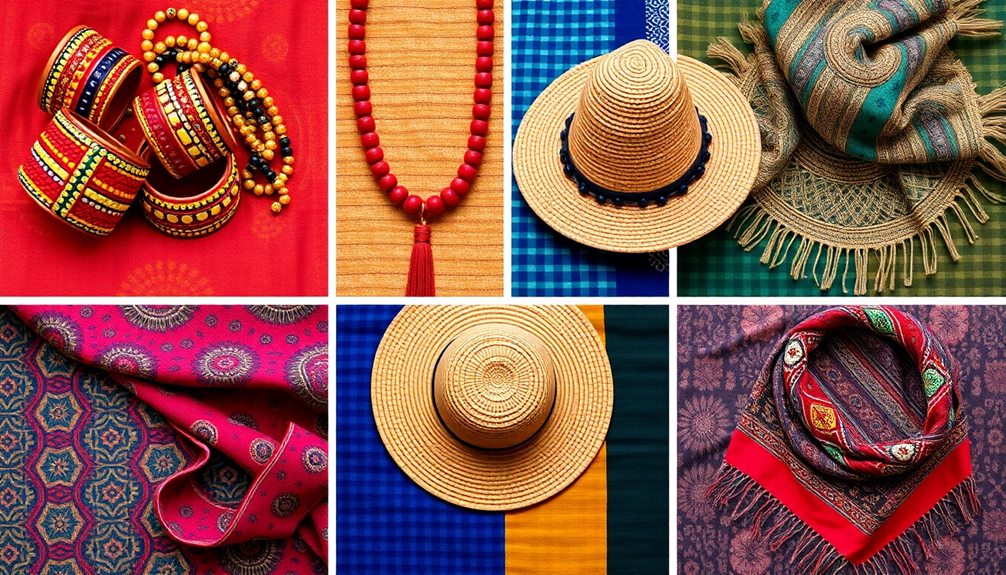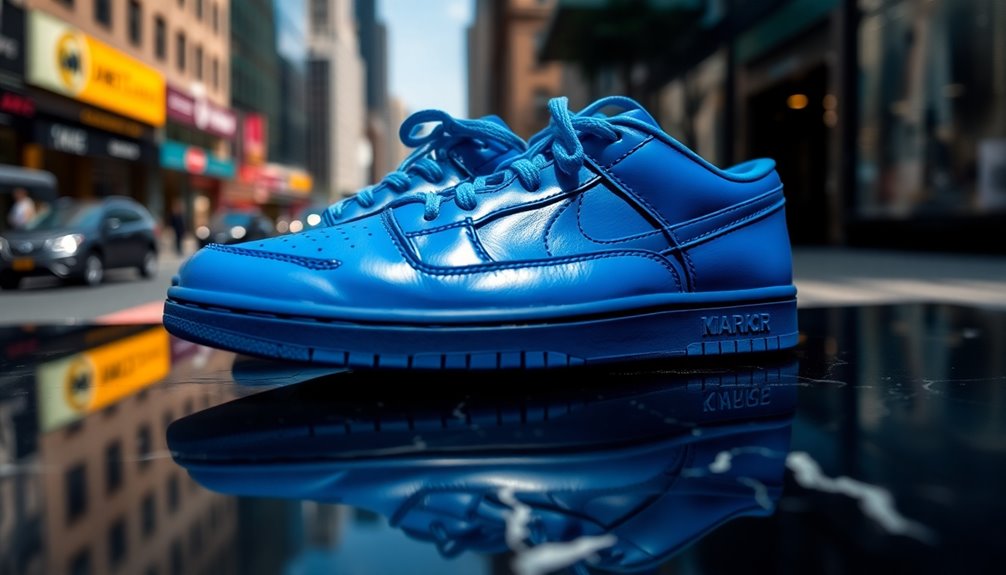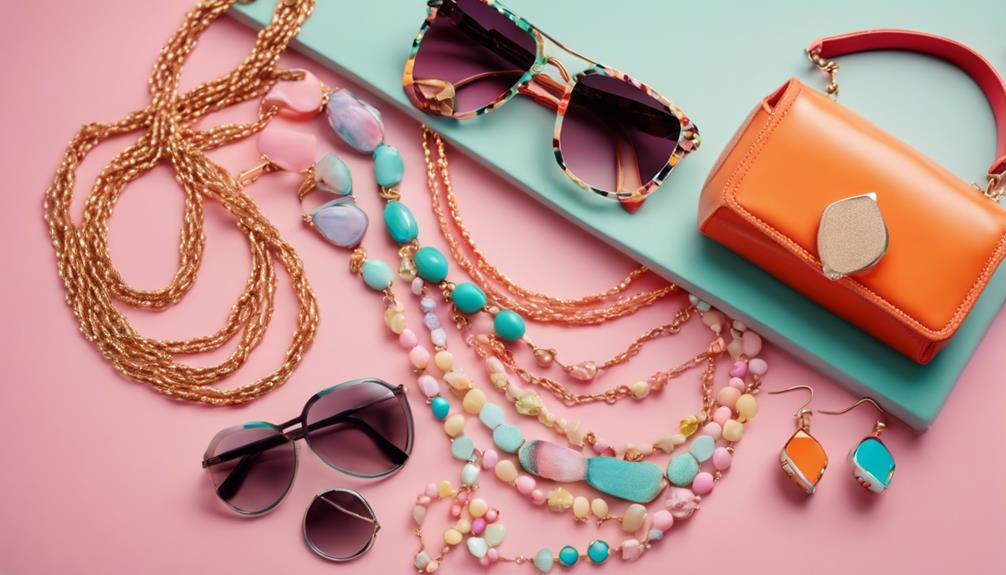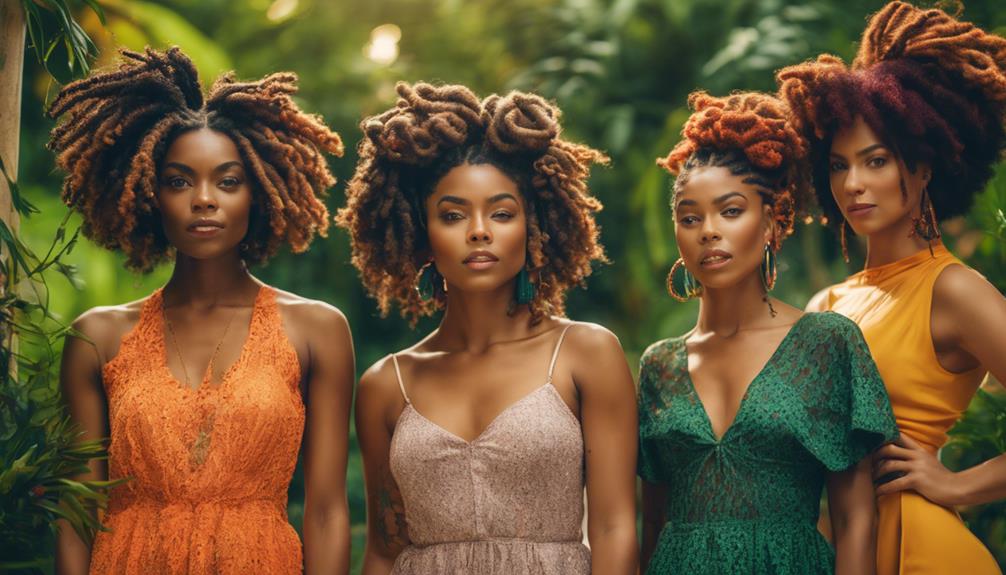Cultural fashion accessories connect you to rich traditions worldwide, enhancing your style and identity. From the Indian bindi reflecting spirituality to African beadwork signifying status, each piece tells a story. Celebrate in vibrant jewelry like Mexican silver filigree or Middle Eastern bangles, essential for festivals. Traditional headwear, such as colorful gele wraps or Scottish tam o'shanters, showcases your heritage. Explore how global trends merge traditional and modern styles while considering ethical choices in your selections. These accessories aren't just fashion statements; they're meaningful expressions of culture and history that can elevate your wardrobe in surprising ways.
Key Takeaways
- Cultural accessories, like African beadwork and Indian bindis, carry deep historical and social meanings beyond their visual appeal.
- Traditional jewelry enhances celebrations, with pieces like Indian gold adornments and African necklaces symbolizing heritage and status.
- Headwear, such as Maori headdresses and colorful gele, represents cultural identity and varies significantly by region.
- Global fashion trends blend traditional attire, like Indian sarees and African kente cloth, with modern aesthetics, creating unique styles.
- Ethical considerations in fashion emphasize cultural respect, sustainable materials, and support for local artisans to preserve craftsmanship.
Understanding Cultural Significance
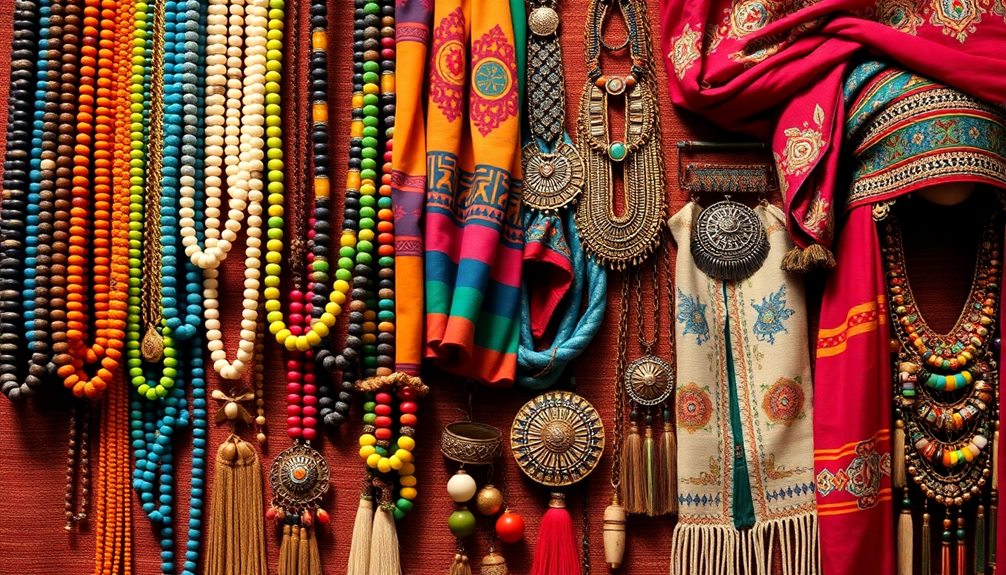
Cultural accessories aren't just decorative items; they hold deep historical and social significance. When you wear a piece of jewelry or a hat, you mightn't realize how much it represents your cultural roots.
For instance, traditional beadwork in many African cultures isn't merely about aesthetics; it conveys social status and tribal affiliation, connecting wearers to their heritage. Similarly, the Indian bindi serves as a powerful symbol of marital status and spirituality, reminding you of the traditions that shape personal identities.
In Japan, kintsugi pottery showcases the beauty of embracing imperfections, integrating gold to highlight the value of restoration—this philosophy reflects a unique cultural insight. Engaging with Waldorf toys can also foster a deeper understanding of cultural narratives, encouraging children to explore their heritage through imaginative play.
You'll also find that the Mexican sombrero isn't just a festive hat; it signifies regional identity and cultural pride, often worn during celebratory events.
Indigenous peoples of North America use symbolic patterns and colors in their jewelry to tell stories of tribal history, deepening the connection to their cultural narrative. Each accessory tells a story, reminding you that when you wear them, you're not just following a trend; you're embracing a rich tapestry of cultural significance.
Essential Accessories for Celebrations
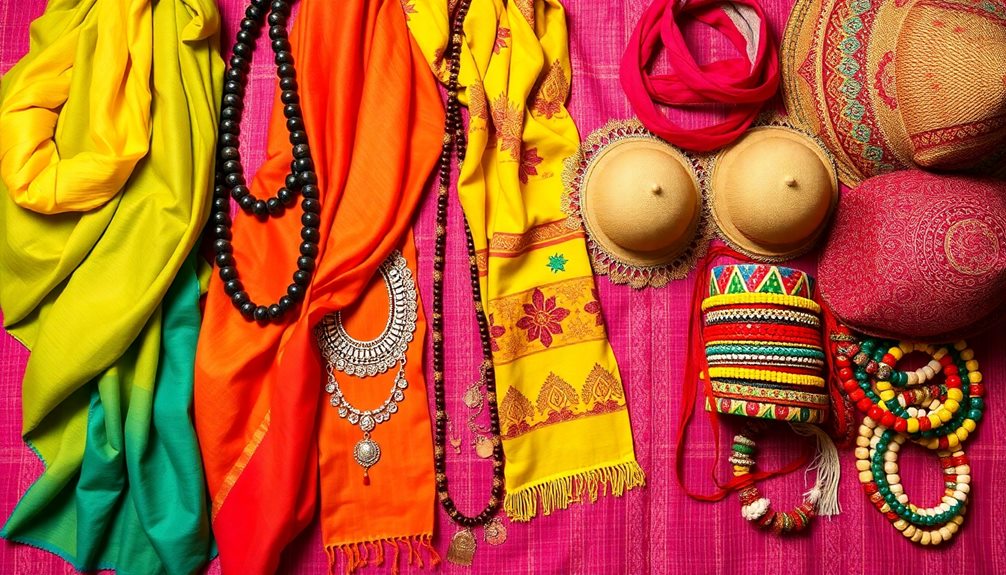
When it comes to celebrations, festive jewelry and traditional headwear can really elevate your look.
You can express your cultural heritage while adding a unique touch to your outfit.
Let's explore how these accessories not only enhance your style but also carry significant meaning.
Festive Jewelry Highlights
As celebrations approach, festive jewelry becomes a key element in expressing joy and heritage. These vibrant accessories not only enhance your outfit but also carry significant cultural meanings. Here are some festive jewelry highlights that you shouldn't miss:
- Indian Gold and Silver Adornments: Often seen in weddings, these pieces reflect cultural significance and are crucial for showcasing elegance during celebrations.
- African Beaded Necklaces and Earrings: These intricate designs serve as symbols of heritage and status, making them indispensable for various festivals and important events.
- Traditional Mexican Jewelry: Silver filigree earrings and colorful woven bracelets are crafted with care and are often worn during cultural festivities like Día de los Muertos.
Incorporating these pieces into your attire not only beautifies your look but also pays homage to the rich traditions they represent.
From elaborate Middle Eastern gold bangles to Maori taonga, each piece tells a story of cultural pride.
Traditional Headwear Significance
Festive jewelry isn't the only way to showcase your cultural heritage during celebrations; traditional headwear also plays a significant role. It often symbolizes cultural identity, with styles varying widely across regions. For example, you might wear a turban in South Asia, a sombrero in Mexico, or a kippah in Jewish communities. Each piece carries its own story.
Many cultures utilize traditional headwear for ceremonial purposes. Take the Maori's feathered headdress, which signifies status and accomplishment during significant events. In Africa, colorful headwraps, known as gele, serve as both fashion statements and cultural expressions, especially during weddings and celebrations that honor ancestry.
The significance of traditional headwear is deeply rooted in history. For instance, the Scottish tam o'shanter represents national pride and heritage. Additionally, headwear can have religious implications, like the hijab in Islam, worn as a sign of modesty and devotion.
In essence, traditional headwear enriches your celebrations, reflecting cultural heritage and adding depth to your festive attire. Embracing these pieces not only enhances your look but also keeps cultural narratives alive.
Global Styles and Trends
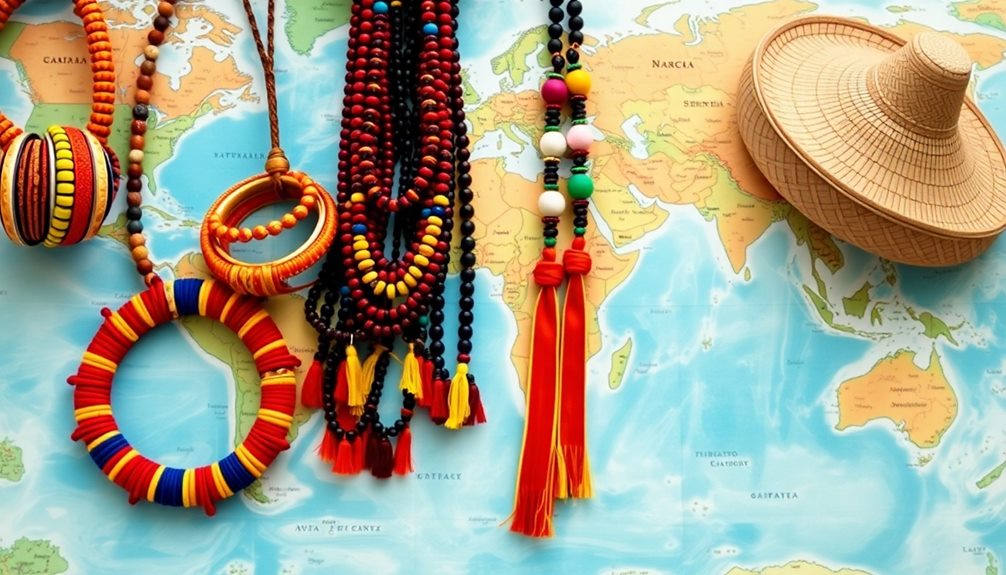
When you explore global styles and trends, you'll see how traditional attire, like Indian sarees and Japanese kimonos, carries deep cultural significance and craftsmanship.
Each region's fashion influences the broader landscape, showcasing vibrant colors and prints that symbolize community and identity, especially in African fashion.
Similarly, traditional Indonesian clothing reflects the country's rich ethnic diversity and cultural heritage, often featuring intricate patterns and natural materials traditional housing styles.
Traditional Attire Significance
Traditional attire serves as a vibrant tapestry woven with the threads of cultural heritage and identity, reflecting the unique history and values of different communities. When you don traditional clothing, you're not just wearing fabric; you're embracing a narrative that connects you to your roots.
Each culture's cuisine, like the cultural influences in Brazilian dishes, often parallels its traditional clothing, highlighting the shared history and values of the community.
Here are three key aspects of traditional attire significance:
- Cultural Expression: Each piece tells a story. For instance, the saree in India varies by region, symbolizing femininity and grace, while the huipil in Mexico showcases family history and cultural beliefs.
- Community Identity: Garments like the dashiki and kente cloth in African culture serve as symbols of pride and heritage. When worn, they reinforce a sense of belonging and collective identity.
- Ceremonial Importance: Traditional clothing is often worn during significant ceremonies and festivals. These occasions strengthen community bonds and shared values, highlighting the importance of cultural heritage in everyday life.
Global Fashion Influences
Cultural attire isn't just about history; it also sets the stage for global fashion influences that shape contemporary styles. Each piece of traditional clothing, from Indian sarees to Japanese kimonos, reflects rich cultural heritage and tells a story.
As you explore global fashion trends, you'll notice how these unique styles blend with modern aesthetics, creating something entirely new. For instance, the vibrant prints and bold colors of African fashion bring a rejuvenating contrast to the sleek designs of Parisian catwalks.
Meanwhile, Asian streetwear fuses hip-hop culture with traditional elements, resulting in distinctive looks that vary between cities like Tokyo and Hong Kong. American fashion, led by iconic brands like Levi's and Converse, has also played a pivotal role, popularizing denim and casual footwear worldwide.
Incorporating these global styles into your wardrobe not only enhances your fashion aesthetics but also promotes cultural appreciation. By embracing diverse fashion narratives, you celebrate the beauty of individuality and the richness of global influences, making your style a canvas for cultural expression.
Cultural Color Symbolism
Colors play an essential role in expressing identity and emotions across different cultures, often conveying messages that go beyond mere aesthetics. Understanding cultural color symbolism can deepen your appreciation for diversity during global celebrations.
Here are three key examples to reflect on:
- India: Saffron and red are vibrant during celebrations, symbolizing festivity and auspiciousness, while white represents mourning, highlighting the duality of life.
- Brazil: The bright green and yellow colors during Carnival showcase national pride, reflecting the country's rich culture and strong community ties.
- Africa: Bold hues symbolize strength and energy in traditional ceremonies, reinforcing community ties and shared heritage.
In Middle Eastern cultures, blue is significant for protection and warding off evil, often featured in clothing and decorative items.
By recognizing these meanings, you not only enrich your wardrobe but also foster respect and connection with different traditions.
Embrace the power of color in your fashion choices; it's a celebration of culture that enhances your style while honoring diverse communities.
Traditional Attire Around the World
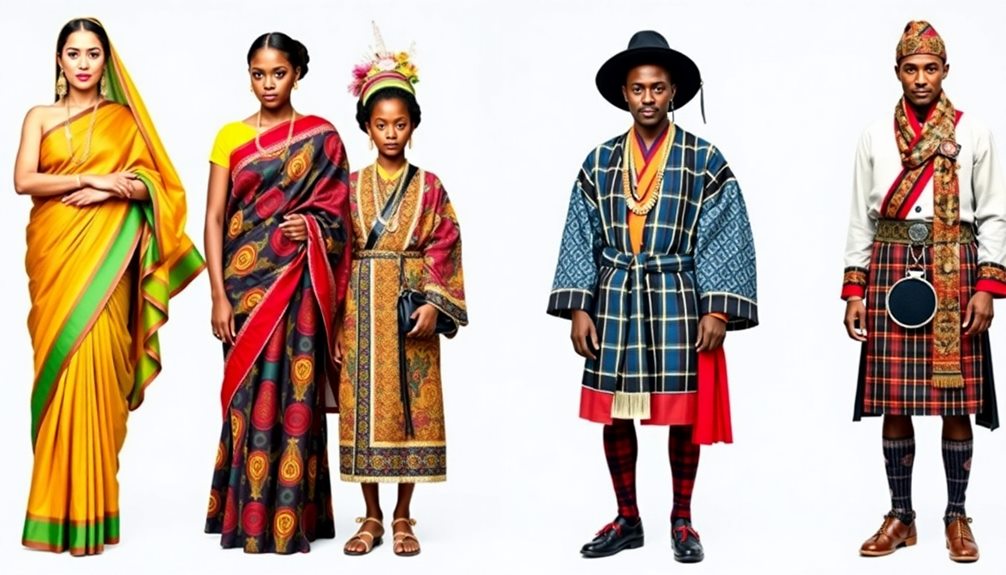
Around the globe, attire reflects the rich tapestry of cultural heritage and identity. Traditional attire varies widely, showcasing the uniqueness of each region.
For instance, Indian sarees display diverse regional styles, fabrics, and colors, embodying local customs and heritage. In Mexico, huipiles are hand-embroidered garments that convey community beliefs, often worn during significant cultural events, highlighting their cultural significance.
Middle Eastern garments feature intricate embroidery, showcasing craftsmanship that often signifies social status or regional identity. The beautiful fabrics and unique patterns of Japanese kimonos serve as symbols of cultural identity, worn during festivals and ceremonies that emphasize tradition and elegance.
African clothing, like the vibrant kente cloth from Ghana, uses bold prints to convey cultural significance, representing important life events and social standing.
Each piece of traditional attire not only tells a story but also connects you to the history and values of your community. By embracing these garments, you celebrate the diversity and richness of global cultures while honoring the traditions that have shaped them.
Whether it's a saree or a kimono, traditional attire is an essential expression of who you're and where you come from.
Modern Influences on Fashion

Modern fashion is shaped by a dynamic mix of influences that reflect our ever-changing society. You'll notice how trends from urban centers like Tokyo and Hong Kong blend traditional aesthetics with contemporary styles.
Social media plays a crucial role here, accelerating the rise of micro-trends and giving niche brands the spotlight they deserve.
Consider these key modern influences on fashion:
- Y2K Resurgence: This nostalgic trend brings back retro-futuristic styles, bold colors, and a sense of playful rebellion that you can easily incorporate into your wardrobe.
- Quiet Luxury: Emphasizing timeless elegance over conspicuous branding, this trend encourages you to invest in quality pieces that speak to your refined taste.
- Sustainable Fashion: With eco-consciousness on the rise, more brands are adopting ethical practices. You can participate by choosing eco-friendly materials that not only look good but also feel good on your conscience.
These modern influences on fashion are reshaping how you view style, making it more inclusive and reflective of global culture.
Embrace these changes and let them inspire your fashion choices!
Ethical Considerations in Accessory Choices
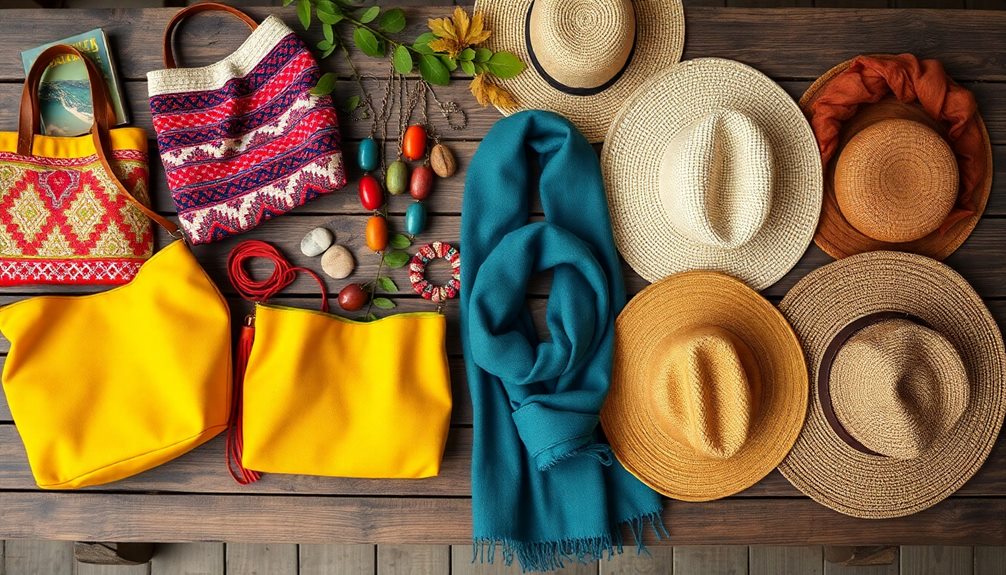
As you explore the latest trends in fashion, it’s important to contemplate the ethical implications of your accessory choices. Opting for eco-friendly materials, like organic cotton or recycled metals, can greatly reduce your environmental impact and promote sustainability in fashion. Moreover, supporting brands that prioritize ethical practices ensures that your purchases contribute to a more positive industry landscape. By showcasing these products through innovative and engaging designs, designers can effectively highlight the significance of sustainable materials in fashion photography. This not only elevates the aesthetic appeal of the items but also reinforces the message of responsible consumerism and environmental stewardship.
By choosing accessories from ethical brands, you not only enhance your personal style but also support fair labor practices, guaranteeing workers receive fair wages and work in safe conditions.
Additionally, consider the cultural significance of your accessories. Being mindful of how certain items relate to traditions and customs can help you avoid cultural appropriation and foster respect for diverse backgrounds.
Supporting local artisans by purchasing handmade items not only preserves traditional craftsmanship but also contributes to the economic well-being of their communities.
Incorporating accessories from sustainable fashion brands allows you to express your individuality while reflecting a commitment to ethical consumerism. This thoughtful approach guarantees that your choices resonate beyond mere aesthetics, aligning your style with values that matter.
Ultimately, your accessory choices can make a positive difference—both for the planet and the people who inhabit it.
Frequently Asked Questions
How Can I Ensure My Accessory Choices Are Culturally Respectful?
To guarantee your accessory choices are culturally respectful, research the origins and meanings behind them. Engage with communities, seek guidance, and avoid appropriating symbols that don't belong to your culture. Respect and understanding go a long way.
What Materials Are Commonly Used in Traditional Cultural Accessories?
When you explore traditional cultural accessories, you'll find materials like silk, leather, and wood weaving stories of heritage. These elements reflect craftsmanship and identity, inviting you to appreciate the artistry behind each piece you choose.
Are There Universal Symbols in Fashion Accessories Across Cultures?
Yes, there are universal symbols in fashion accessories, like the heart representing love or the peace sign symbolizing harmony. You'll often find these symbols transcending cultures, connecting people through shared meanings and emotions in style.
How Do I Care for Delicate Cultural Accessories?
Did you know 70% of people overlook proper care for delicate accessories? To care for yours, gently clean with a soft cloth, store them in a cool, dry place, and avoid exposing them to harsh chemicals.
Can I Mix Modern and Traditional Accessories Without Offending Anyone?
You can definitely mix modern and traditional accessories! Just be mindful of cultural significance. Respect the origins and meanings behind each piece, and you'll likely create a harmonious blend that celebrates both styles without offending anyone.
Conclusion
Incorporating essential cultural fashion accessories not only enhances your style but also deepens your appreciation for global traditions. By understanding the significance behind each piece, you celebrate diversity and connect with different cultures. Whether it's a colorful scarf or a handcrafted necklace, these accessories can transform any outfit. So, why not embrace the beauty of global fashion and let your accessories tell a story? Your wardrobe can become a canvas of rich cultural narratives waiting to be explored!
